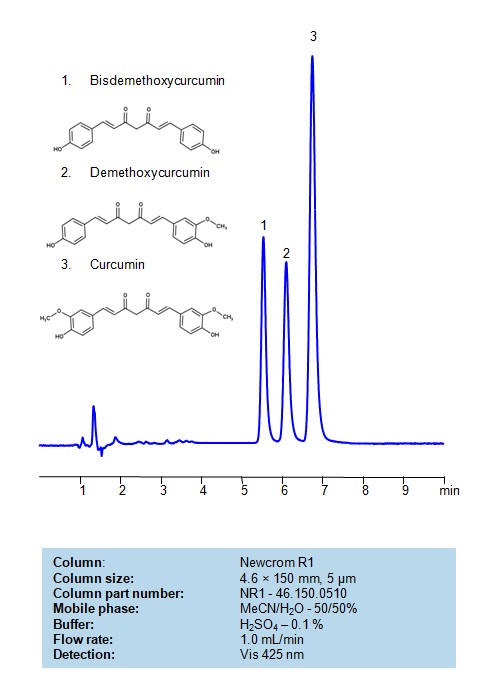HPLC Method for Analysis of Curcumin, Bisdemethoxycurcumin, Demethoxycurcumin on Newcrom R1 Column by SIELC Technologies
Separation type: Liquid Chromatography Reversed-phase

Turmeric is a yellow spice derived from the rhizomes of the plant Curcuma longa. It has been used for centuries in culinary and medicinal traditions, especially in Indian and Southeast Asian cultures. One of the main bioactive components responsible for many of turmeric’s potential health benefits is curcumin.
The curcumin content in turmeric varies depending on the source and preparation, but typically, dried turmeric powder contains about 2-5% curcumin by weight. This relatively low percentage is one reason why many curcumin supplements are made using extracts to provide a concentrated dose.
Curcumin is not a single compound but is rather a mixture of related compounds known as curcuminoids.
Curcuminoids are a group of polyphenolic compounds found in turmeric (Curcuma longa). They are responsible for the yellow color of the turmeric spice and are also the main bioactive components believed to be responsible for many of the potential health benefits of turmeric.
The three primary curcuminoids in turmeric are:
Curcumin (diferuloylmethane): This is the primary and most studied component, accounting for 60-70% of the curcuminoids in turmeric.
Demethoxycurcumin: This compound constitutes about 20-27% of the curcuminoids.
Bisdemethoxycurcumin: This makes up around 10-15% of the curcuminoids.
These compounds have been studied for their potential anti-inflammatory, antioxidant, anticancer, and neuroprotective properties, among others. Due to their low bioavailability, many formulations, such as those combined with piperine (from black pepper), have been developed to enhance absorption in the body.
Curcuminoids can be retained, separated, and analyzed on a mixed-mode Newcrom R1 column with a mobile phase consisting of water, Acetonitrile (MeCN), and sulfuric acid. This analytical method can be detected with high resolution and peak symmetry at a wavelength of 425 nm using Vis detection
High Performance Liquid Chromatography (HPLC) Method for Analyses of Curcumin, Bisdemethoxycurcumin, Demethoxycurcumin on Newcrom R1 Column by SIELC Technologies
Condition
| Column | Newcrom R1, 0.5 x 150 mm, 5 µm, 100 A, dual ended |
| Mobile Phase | MeCN/H2O – 50/50%, |
| Buffer | H2SO4 – 0.2% |
| Flow Rate | 1.0 ml/min |
| Detection | Vis 425 nm |
Description
| Class of Compounds | Polyphenols |
| Analyzing Compounds | Curcumin, Bisdemethoxycurcumin, Demethoxycurcumin |
Application Column
Newcrom R1
Column Diameter: 0.5 mm
Column Length: 150 mm
Particle Size: 5 µm
Pore Size: 100 A
Column options: dual ended
Curcumin
Demethoxycurcumin





